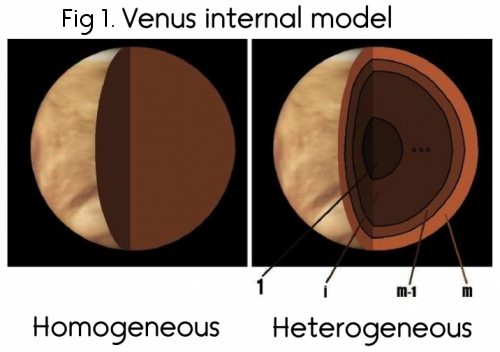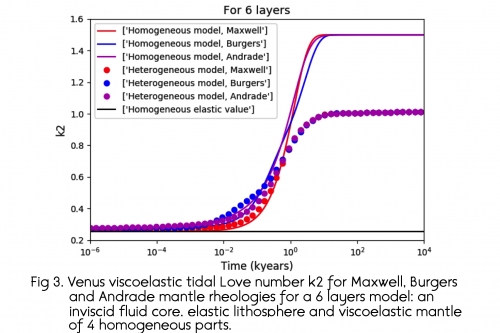Exploring Venus internal structure by its tidal response
- 1Geoazur, Université Côte d’Azur, Observatoire de la côte d’azur, Valbonne, France (christelle.saliby@geoazur.unice.fr)
- 2Dipartimento di Scienze Pure e Applicate (DiSPeA), Urbino University, Urbino, Italy
- 3Istituto Nazionale di Geofisica e Vulcanologia, Rome, Italy
Tidal forces acting on a planet cause a deformation and mass redistribution in its interior, involving surface motions and variation in the gravity field, which may be observed in geodetic experiments. The change in the gravitational field of the planet, due to the influence of an external gravity field, described primarily by its tidal Love number k of degree 2 (denoted by k2) can be observed from analysis of a spacecraft radio tracking. The planet's deformation is linked to its internal structure, most effectively to its density and rigidity. Hence the tidal Love number k2 can be theoretically approximated for different planetary models, which means comparing the observed and theoretical calculation of k2 of a planet is a window to its internal structure.

The terrestrial planet Venus is reminiscent of the Earth twin planet in size and density, which leads to the assumption that the Earth and Venus have similar internal structures. In this work, with a Venus density profile computed by Aitta [2012] and assuming that the planet in question is in hydrostatic equilibrium, we investigate the elastic parameters of each of Venus major layers to calculate its tidal Love number k2. The calculation of k2 is done with ALMA, a Fortran 90 program by Spada [2008] for computing the tidal and load Love numbers using the Post-Widder Laplace inversion formula. After implementing the Andrade rheology to ALMA, we investigate several different rheologies for the mantle of Venus as Maxwell, Burgers and Andrade rheologies.

The tidal Love number k2 of Venus is of 0.3±0.024, depending on the mantle rheology and number of mantle layers. With a more heterogeneous model, equivalently a higher number of layers, difference of the k2 values between different mantle rheology models decreases. An Andrade rheology model has indeed an apparent transient phase which manifests after 10 years, this phase makes the transition between short-term (before 10 years) and long-term (after 100 years) gravity field deformation smoother than that of Maxwell and Burgers. The curve of k2 for Burgers rheology for a three layers model is relatively uneven, it gets smoother while adding more layers. From the tidal Love number k2, we also conclude the dissipation function Q-1 and the tide-induced phase lag ε of Venus. Finally we compare the values obtained for k2, Q-1and with that of the work of different authors.
References:
How to cite: Saliby, C., Fienga, A., Spada, G., Memin, A., and Melini, D.: Exploring Venus internal structure by its tidal response, Europlanet Science Congress 2020, online, 21 September–9 Oct 2020, EPSC2020-237, https://doi.org/10.5194/epsc2020-237, 2020

